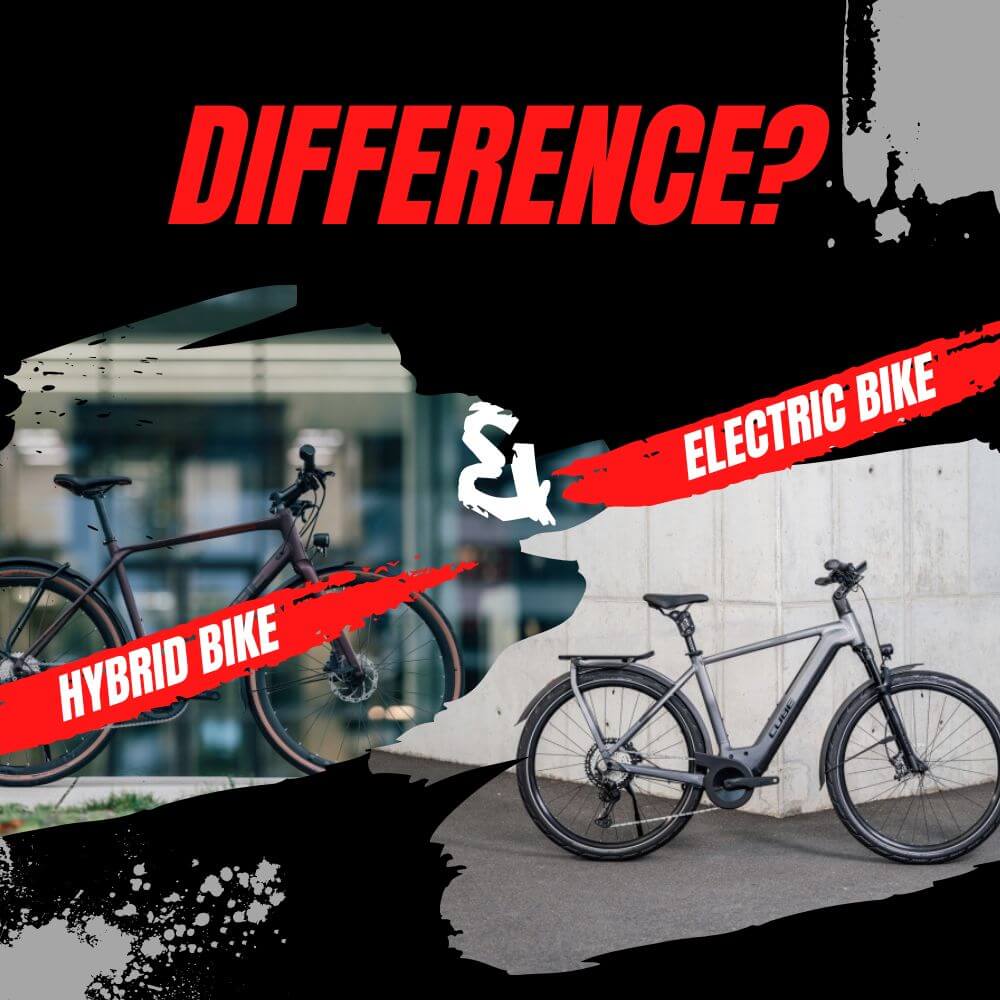A hybrid bike relies on the rider’s pedaling power, while an electric bike provides assistance through a motor. Hybrid bikes combine road and mountain bike features for versatile riding.
They are suitable for various terrains and activities, offering a balance between speed and comfort. Electric bikes, on the other hand, assist the rider with a motor, making uphill climbs and long distances more manageable. The hybrid bike requires physical effort, while the electric bike offers motorized support, allowing for a more effortless riding experience.
Both types of bikes cater to different preferences and needs, providing unique advantages for cyclists looking to enhance their riding capabilities.
Key Differences between an Electric Bike And a Hybrid
An electric bike and a hybrid bike may appear similar at first glance, but there are key differences that set them apart. Understanding these differences can help you make an informed decision when considering which type of bike is best suited for your needs.
Motorization
Electric bikes are equipped with an electric motor that provides propulsion, allowing riders to travel with minimal effort. In contrast, hybrid bikes rely solely on human power, requiring riders to pedal without motor assistance.
Pedal Assistance
Electric bikes offer varying levels of pedal assistance, with the motor providing additional power as the rider pedals. On the other hand, hybrid bikes do not feature pedal assistance and require riders to rely entirely on their own pedaling for propulsion.
Performance
When it comes to performance, electric bikes and hybrid bikes have distinct differences in terms of speed and terrain adaptability. Understanding these differences can help you choose the right type of bike for your needs.
Speed
Electric bikes, also known as e-bikes, are equipped with an electric motor that provides assistance while you pedal. This motor allows for higher speeds compared to traditional hybrid bikes. E-bikes have different speed settings that can vary depending on the model, with some capable of reaching speeds up to 28 mph.
On the other hand, hybrid bikes rely solely on human power and do not have a motor, which means their speed is limited to the rider’s physical capabilities.
Terrain Adaptability
Both electric bikes and hybrid bikes are designed to handle various terrains, but there are differences in their adaptability. Hybrid bikes are versatile and can handle a wide range of surfaces, including paved roads, gravel paths, and light off-road trails. They typically have wider tires and a more upright riding position, providing stability and comfort.
Electric bikes, while also suitable for urban environments and light off-road trails, have an added advantage when it comes to tackling hilly terrains. The electric motor provides assistance in climbing steep inclines, making it easier for riders to conquer challenging hills without exerting excessive physical effort.
Overall, electric bikes offer a higher level of performance in terms of speed and terrain adaptability due to their electric motor assistance. However, hybrid bikes are still a viable option for those looking for a versatile and comfortable ride without the need for motor assistance.
Functionality
Understanding the primary use and versatility of electric bikes and hybrids is key to choosing the right option that suits your needs.
-
Primary Use
Electric bikes are ideal for individuals looking for effortless commuting or recreational rides without much physical exertion. On the other hand, hybrids are versatile for both city commuting and light off-road adventures.
-
Versatility
Electric bikes offer convenience with motor assistance, making uphill climbs easier. Hybrids, on the other hand, provide a balance between road and off-road capabilities, suitable for diverse riding terrains.
Construction
An electric bike and a hybrid vary in their construction, influencing their performance and usage. Let’s explore the key differences.
-
Frame
The frame of an electric bike is primarily designed to accommodate the motor and battery components, often made of lightweight yet durable materials like aluminum alloy or carbon fiber.
-
Weight
Electric bikes tend to be heavier than hybrids due to the added motor and battery, impacting maneuverability and ease of handling.
Riding Experience
Experience the thrill of riding with the key distinction being that electric bikes provide motor assistance, while hybrids rely solely on pedaling power. Electric bikes offer an extra boost for effortless rides, while hybrids blend road and mountain bike features for versatile cycling adventures.
-
Riding Dynamics
When it comes to the riding experience, both electric bikes (e-bikes) and hybrids offer unique features that cater to different preferences. Electric bikes are known for their smooth and effortless riding experience. With the assistance of a motor, riders can effortlessly conquer hills and cover long distances with less physical exertion. The motor in an electric bike offers different levels of power assistance, allowing riders to easily adjust the speed and effort required while pedaling.
-
Physical Exertion
On the other hand, hybrids provide a more traditional biking experience with some added advantages. Unlike electric bikes, hybrids require more physical exertion as they don’t have a motorized assistance. This means riders rely solely on their own pedaling power to propel the bike forward. This can be a great option for those seeking a more active workout or for individuals who enjoy the feeling of exerting themselves while riding.
Additionally, the physical exertion involved in riding a hybrid bike can be beneficial for improving cardiovascular fitness and building strength in the legs and core. It offers a more engaging and immersive riding experience, where every pedal stroke contributes to the bike’s momentum. This can be particularly appealing for individuals who enjoy the physical challenges of biking and prefer a more hands-on approach to riding.
Environmental Impact
When it comes to choosing between an electric bike and a hybrid, understanding the environmental impact of each option is crucial. By examining the emissions and sustainability of these bikes, you can make an informed decision that aligns with your eco-conscious values.
-
Emissions
One of the key differences between electric bikes and hybrids lies in their emissions. Electric bikes are powered by rechargeable batteries and produce zero tailpipe emissions. This means that when you ride an electric bike, you’re not contributing to air pollution or greenhouse gas emissions. On the other hand, hybrids typically use gasoline engines, which do emit pollutants and contribute to carbon dioxide emissions.
By opting for an electric bike, you can reduce your personal carbon footprint and contribute to cleaner air in your community. This makes electric bikes a greener and more environmentally friendly transportation option.
-
Sustainability
When it comes to sustainability, electric bikes have a clear advantage over hybrids. Electric bike batteries can be charged using renewable energy sources such as solar or wind power. This means that the energy used to power your electric bike can come from clean and sustainable sources, further reducing the environmental impact.
In contrast, hybrid bikes rely on gasoline, a finite fossil fuel resource that contributes to climate change and environmental degradation. The extraction, refining, and transportation of gasoline have significant ecological consequences, making hybrids less sustainable compared to electric bikes.
- Electric bikes can be charged using renewable energy sources like solar or wind power
- Hybrids rely on finite fossil fuel resource – gasoline
- Gasoline extraction, refining, and transportation have significant ecological consequences
By understanding the environmental impact of electric bikes and hybrids, you can make a conscious choice that aligns with your values. Electric bikes offer a clean and sustainable transportation alternative with zero emissions and the ability to recharge using renewable energy sources. On the other hand, hybrids rely on gasoline and contribute to air pollution and carbon emissions. Consider the environmental implications when deciding between an electric bike and a hybrid, and make a choice that supports a greener future.
Cost and Maintenance
When considering an electric bike compared to a hybrid, it’s important to analyze the costs involved, both in terms of the initial investment and the long-term expenses.
-
Initial Investment
Electric bikes typically have a higher initial cost than hybrids, mainly due to the advanced technology and the integration of an electric motor and battery. On the other hand, hybrid bikes are generally more affordable, as they do not involve complex electrical components.
-
Long-term Expenses
Electric bikes may incur higher long-term expenses due to the maintenance and replacement of the electric components, particularly the battery. Additionally, specialized electric bike maintenance may require professional services, leading to increased costs over time. Conversely, hybrid bikes usually have lower long-term expenses as they rely on traditional mechanical components that are generally less expensive to maintain and replace.
Frequently Asked Questions Of What Is The Difference Between An Electric Bike And A Hybrid
What Are The Disadvantages Of Hybrid Bikes?
The disadvantages of hybrid bikes include less speed compared to road bikes due to wider tires and heavier usage, making them less suitable for competitive cycling. However, they are still a good choice for urban commuting and weekend rides. Hybrid bikes are not as sporty as mountain bikes and may not handle rough terrains as well.
Overall, they are versatile but may not excel in specific areas.
What Does Hybrid Mean On An Electric Bike?
A hybrid electric bike combines pedal power with an electric motor to assist while riding. This means no more struggling over hills or arriving at work exhausted.
What Are Hybrid Bikes Best For?
Hybrid bikes are versatile and suitable for various activities such as commuting, shopping, and leisurely rides. They offer comfort and robustness for urban and off-road terrains, making them ideal for city and countryside use.
What Is The Purpose Of Hybrid Bikes?
Hybrid bikes blend road and mountain bike features for versatile riding with speed and comfort.
Conclusion
To summarize, the main difference between electric bikes and hybrids is the assistance they provide. While hybrids rely solely on the rider’s pedaling power, electric bikes offer a selectable amount of assistance through an onboard computer. This assistance makes electric bikes ideal for those seeking an easier ride, especially when facing hills or long distances.
On the other hand, hybrids maintain the characteristics of both road and mountain bikes, providing a balance between speed and comfort. Ultimately, the choice between the two depends on individual preferences and needs.




